en español
For small to medium businesses, customization is important when building out a telecommunication solution. An on-premise VoIP solution is a popular IT system as it allows businesses to create a scalable solution to fit their needs. One of the major functionalities that a VoIP system delivers is call center features that allow for organizations to implement their own localized call center to better serve their customer base. Grandstream Networks’ UCM series of IP PBXs have built-in call center features that allow businesses to run their call centers efficiently and effectively. In this blog, we take you through the major call center features in the UCM series and how to best utilize them.
Call Queues
Call queues are part of the fundamental building blocks of every call center system. Typically, a call queue consists of callers, agents, a strategy, and hold music. The incoming calls or “callers” are placed into the queue where the answering “agents” are assigned to answer the calls. The call queue strategy in place dictates how the PBX will distribute the incoming calls to the agents. As callers are waiting in the queue, hold music or advertisements are aired, filling the void. There are 6 different strategy types for the call queue that organizations can choose from:
- Ring All: All available agents will be called simultaneously until one answers
- Linear: Agents will be called in a specific order
- Least Recent: The agent who has been called the least recently will receive the call
- Fewest Calls: The agent with the fewest completed calls will receive the call
- Random: An agent will be called randomly
- Round Robin: Agents will be called in Round Robin scheduling
The UCM series also supports a Virtual Call Queue that allows customers to receive a callback instead of waiting on hold. After the customer’s waiting time exceeds a certain threshold, they will be prompted to choose between remaining in the call queue or leaving a call back number without losing their position in the queue. The callback number is then automatically dialed by the UCM when the customer’s place in the queue has been reached. This feature alleviates long wait times on hold during peak hours, improving customer experience overall. Additionally, the UCM supports call queue position announcement, which allows the caller to determine where they stand in the queue.
Monitoring
The UCM supports monitoring features that allow supervisors or coordinators to assist agents throughout the call process. With call barging, supervisors can use feature codes to perform the following functions:
- Listen: In listen mode, the extension monitoring the call can hear both parties in the active call, but the listener will remain muted
- Whisper: In whisper mode, the extension monitoring the call can hear both parties in the active call, but can only be heard by the agent on the call
- Barge: In barge mode, the extension monitoring the call can listen and speak to all parties on the active call, similar to 3-way audio conferencing
These features allow for hands-on training of the agents while still allowing for supervision by managers to better gauge the agents’ actions while on the call. The UCM also has built-in call queue statistics for performance measurement and agent evaluation. This data can also be broken down for each queue separately or the system altogether. Managers and supervisors can use this information to improve the call center’s day-to-day operations either for one queue or the system as a whole. The data includes information on call distribution, login/logout records, start and end times, and virtual queue information. The supervisors have the option to manually download these statistics or program an automatic download at a specified frequency.
Computer Telephony Integration (CTI)
Computer Telephony Integration refers to any technology or solution that allows the integration between telephone and computer networks. This functionality is an important building block of the call center solution allowing agents more flexibility when handling a high volume of calls. Agents are able to perform most call control functions on their desktop in just a few clicks. Grandstream’s solutions are designed to ease the workload of agents with the GS Affinity application and a web-based switchboard. The UCMs have a simple and easy way to use the switchboard for real-time monitoring of call queues and performing different operations which include:
- List of waiting calls
- List of proceeding calls
- Ability to manipulate proceeding calls
- List the Agent’s status
Users can access the call queue switchboard through the user portal and the queue chairman. Agents can log into the web GUI portal using their extension number and their user password. The user portal allows access to a variety of features including user information, extension configuration, settings, and more. Each agent can log into their user portal account and access the call queue switchboard where they will then have the ability to control their calls and status. Another way to access this switchboard is through the queue chairman, providing a CTI interface for the supervisors. The queue chairman has more advanced features and control over the call queue than the normal agent user portal access.
CRM
Customer Relationship Management (CRM) is supported through the UCM allowing users to search for contact information collected in the contact record. The UCM can be integrated with popular CRM tools such as SugarCRM, ZOHO CRM, and Salesforce. When integrated with the GS Affinity app, agents are able to retrieve contact information during the calls in order to provide their clients a more personalized experience.
IVR and Call Recordings
Grandstream’s UCM supports a full built-in IVR (Interactive Voice Response) module. Users can create up to a 5-level IVR system to customize their callers’ experience with the ability to select from pre-set options. All of the IVR settings can be managed under the Call Features menu on the user interface. Here, users can record custom prompts, enable key-pressing events to guide callers through, select language, and even set up blacklist & whitelist filters. By using the IVR, businesses can guide inbound phone traffic to help customers reach a desired department or individual without interaction with a live agent.
As with any call center system, call recording is an integral part of the caller’s journey through the call queue. The UCM supports call recording either automatically or through the feature codes for active calls. This allows the administrator to keep a record of all calls under the call queue system for monitoring, statistics, and also to use as learning tools. Once the auto-record feature is enabled, the system will record all calls under the assigned queue in .wav files to be accessed, downloaded, and assessed.
Grandstream’s UCM IP PBX’s call center features provide businesses with a powerful and customizable solution to easily handle a high volume of inbound calls. From call queues to interactive voice response, businesses can adjust the UCM’s settings so that calls are more effectively handled by agents and the customers’ issues are resolved quicker, providing a better overall experience for both the customer and the agent.
Interested in a more technical look at our call center solutions? Watch our technical training video HERE.





